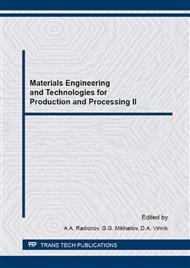[1]
Y. Estrin, A. Vinogradov, Extreme grain refinement by severe plastic deformation: A wealth of challenging science, Acta Materialia. 61 (2013) 782-817.
DOI: 10.1016/j.actamat.2012.10.038
Google Scholar
[2]
Y.H. Ji, J.J. Park, Development of severe plastic deformation by various asymmetric rolling processes, Materials Science and Engineering: A. 499 (2009) 14-17.
DOI: 10.1016/j.msea.2007.11.099
Google Scholar
[3]
A. Pesin, D. Pustovoytov, Influence of Process Parameters on Distribution of Shear Strain through Sheet Thickness in Asymmetric Rolling, Key Engineering Materials. 622-623 (2014) 929-935.
DOI: 10.4028/www.scientific.net/kem.622-623.929
Google Scholar
[4]
A. Pesin, A. Korchunov, D. Pustovoytov, Numerical study of grain evolution and dislocation density during asymmetric rolling of aluminum alloy 7075, Key Engineering Materials. 685 (2016) 162-166.
DOI: 10.4028/www.scientific.net/kem.685.162
Google Scholar
[5]
J.J. Park, Finite-element analysis of severe plastic deformation in differential-speed rolling, Computational Materials Science. 100 (2015) 61-66.
DOI: 10.1016/j.commatsci.2014.09.010
Google Scholar
[6]
F. Zuo, J. Jiang, A. Shan, Shear deformation and grain refinement in pure Al by asymmetric rolling, Transactions of Nonferrous Metals Society of China. 18 (2008) 774-777.
DOI: 10.1016/s1003-6326(08)60133-8
Google Scholar
[7]
Y.H. Ji, J.J. Park, W.J. Kim, Finite element analysis of severe deformation in Mg-3Al-1Zn sheets through differential-speed rolling with a high speed ratio, Materials Science and Engineering: A. 454-455 (2007) 570-574.
DOI: 10.1016/j.msea.2006.11.076
Google Scholar
[8]
W.J. Kim, B.G. Hwang, M.J. Lee, Y.B. Park, Effect of speed-ratio on microstructure, and mechanical properties of Mg-3Al-1Zn alloy, in differential speed rolling, Journal of Alloys and Compounds. 509 (2011) 8510-8517.
DOI: 10.1016/j.jallcom.2011.05.063
Google Scholar
[9]
K. Bobor, Z. Hegedus, J. Gubicza, I. Barkai, P. Pekker, G. Krallics, Microstructure and mechanical properties of Al 7075 alloy processed by differential speed rolling, Periodica Polytechnica Mechanical Engineering. 56 (2012) 111-115.
DOI: 10.3311/pp.me.2012-2.06
Google Scholar
[10]
Y.G. Ko, Effect of differential speed rolling strain on microstructure and mechanical properties of nanostructured 5052 Al alloy, Journal of Alloys and Compounds. 586 (2014) 205-209.
DOI: 10.1016/j.jallcom.2012.10.128
Google Scholar
[11]
Q. Cui, K. Ohori, Grain refinement of high purity aluminum by asymmetric rolling, Materials Science and Technology. 16 (2000) 1095-1101.
DOI: 10.1179/026708300101507019
Google Scholar
[12]
B.B. Hundy, A.P. Green, A determination of plastic stress-strain relations, Journal of the Mechanics and Physics of Solids. 3 (1954) 16-21.
DOI: 10.1016/0022-5096(54)90035-6
Google Scholar
[13]
L.W. Meyer, S. Manwaring, Metallurgical Applications of Shock-Wave and High-Strain-Rate Phenomena, Marcel Dekker, New York, (1986).
Google Scholar
[14]
J.R. Klepaczko, An experimental technique for shear testing at high and very high strain rates, International Journal of Impact Engineering. 46 (1994) 25-39.
DOI: 10.1016/s0734-743x(05)80005-3
Google Scholar
[15]
R.J. Clifton, R.W. Klopp, Pressure shear plate impact testing, in: Metals Handbook, Vol. 8, 9th edition, Mechanical Testing, ASM, Metals Park, Ohio, 1985, pp.230-239.
Google Scholar
[16]
J. Peirs, P. Verleysen, J. Degrieck, Novel technique for static and dynamic shear testing of Ti6Al4V sheet, Experimental Mechanics. 52 (2011) 729-741.
DOI: 10.1007/s11340-011-9541-9
Google Scholar
[17]
M. Isakov, J. Seidt, K. Ostman, A. Gilat, V.T. Kuokkala, Characterization of a ferritic stainless sheet steel in simple shear and uniaxial tension at different strain rates, in: Proceedings of the ASME 2011 International Mechanical Engineering Congress and Exposition. (2011).
DOI: 10.1115/imece2011-63141
Google Scholar
[18]
ASTM. B831: Standard test method for shear testing of thin aluminum alloy products, ASTM International, (2005).
Google Scholar
[19]
D. Rittel, S. Lee, G. Ravichandran, A shear-compression specimen for large strain testing, Experimental Mechanics. 42 (2002) 58-64.
DOI: 10.1007/bf02411052
Google Scholar
[20]
A. Dorogoy, D. Rittel, A. Godinger, Modification of the shear-compression specimen for large strain testing, Experimental Mechanics. 55 (2015) 1627-1639.
DOI: 10.1007/s11340-015-0057-6
Google Scholar


